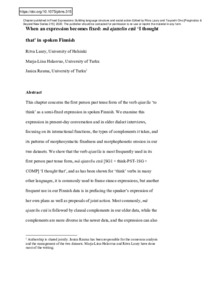When an expression becomes fixed. Mä ajattelin että 'I thought that' in spoken Finnish
Rauma Janica; Laury Ritva; Helasvuo Marja-Liisa
https://urn.fi/URN:NBN:fi-fe2021042826178
Tiivistelmä
This chapter concerns the first person past tense form of the verb ajatella 'to think' as a semi-fixed expression in spoken Finnish. We examine this expression in present-day conversation and in older dialect interviews, focusing on its interactional functions, the types of complements it takes, and its patterns of morphosyntactic fixedness and morphophonetic erosion in our two datasets. We show that the verb ajatella is most frequently used in its first person past tense form, mä ajattelin että [ISG + think-PST-1SG + COMP] 'I thought that', and as has been shown for 'think' verbs in many other languages, it is commonly used to frame stance expressions, but another frequent use in our Finnish data is in prefacing the speaker's expression of her own plans as well as proposals of joint action. Most commonly, mä ajattelin että is followed by clausal complements in our older data, while the complements are more diverse in the newer data, and the expression can also occur without any complements. We also show that while mä ajattelin että 'I thought that' occurs in our data in drastically reduced form and shows signs of morphosyntactic fixedness especially in the newer data, it caanot yet be said to have become an epistemic particle.
Kokoelmat
- Rinnakkaistallenteet [19207]
